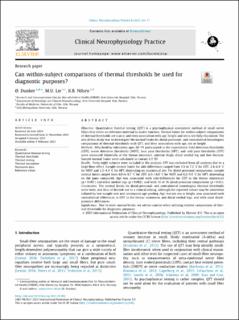Can within-subject comparisons of thermal thresholds be used for diagnostic purposes?
Peer reviewed, Journal article
Published version
Permanent lenke
https://hdl.handle.net/11250/2838554Utgivelsesdato
2021-02-04Metadata
Vis full innførselSamlinger
Originalversjon
Clinical Neurophysiology Practice. 2021, 6 63-71. https://doi.org/10.1016/j.cnp.2021.01.002Sammendrag
Objective: Quantitative thermal testing (QTT) is a psychophysical assessment method of small nerve fibers that relies on reference material to assess function. Normal limits for within-subject comparisons of thermal thresholds are scarce, and their association with age, height and sex is not fully elucidated. The aim of this study was to investigate the normal limits for distal-proximal– and contralateral homologous comparisons of thermal thresholds with QTT, and their association with age, sex or height.
Methods: Fifty healthy volunteers ages 20–79 participated in the experiment. Cold detection thresholds (CDT), warm detection thresholds (WDT), heat pain thresholds (HPT), and cold pain thresholds (CPT) were measured bilaterally at the thenar eminence, anterior thigh, distal medial leg and foot dorsum. Sample normal limits were calculated as (mean) ± 2 SD.
Results: Forty-eight subjects were included in the analysis. CPT was excluded from all analyses due to a large floor-effect. Sample normal limits for side-differences ranged from 1.8 to 7.2 °C for CDT, 2.4–6.8 °C for WDT and 3.2–4.0 °C for HPT, depending on anatomical site. For distal-proximal comparisons, sample normal limits ranged from 4.0 to 8.7 °C for CDT, 6.0–14.0 °C for WDT and 4.2–9.0 °C for HPT, depending on the pairs compared. Age was associated with side-differences for CDT in the thenar eminences (p < 0.001) and distal medial legs (p < 0.002), and with 11 of 18 distal-proximal comparisons (p < 0.01).
Conclusions: The normal limits for distal-proximal- and contralateral homologous thermal thresholds were wide, and thus of limited use in a clinical setting, although the reported values may be somewhat inflated by low sample-size and consequent age-pooling. Age, but not sex or height, was associated with contralateral differences in CDT in the thenar eminences and distal medial legs, and with most distal-proximal differences.
Significance: Due to wide normal limits, we advise caution when utilizing relative comparisons of thermal thresholds for diagnostic purposes.
Utgiver
ElsevierSerie
Clinical Neurophysiology Practice;Volume 6Tidsskrift
Clinical Neurophysiology PracticeOpphavsrett
© 2021 International Federation of Clinical Neurophysiology.Beslektede innførsler
Viser innførsler beslektet ved tittel, forfatter og emneord.
-
Thermal analysis of flat roof systems with regards to their thermal insulation and exterior surface emissivity coefficient
Choidis, Petros; Kontoleon, Karolos; Evgenidis-Karadimitriou, Panagiotis; Mazzeo, Domenico (IOP Conference Series: Earth and Environmental Science;Volume 410, Journal article; Peer reviewed, 2020)In this study, a numerical analysis of the thermal performance of a flat roof system is presented. The dynamic thermal behaviour of this system is assessed with regards to the effects produced by an insulation layer and ... -
Prediction Models for Thermal Conductivity of Cement-based Composites
Hajmohammadian Baghban, Mohammad; Kioumarsi, Mahdi; Grammatikos, Sotirios (Nordic Concrete Research;No. 58 – 1/2018, Journal article; Journal article; Peer reviewed, 2018-10-25)Cement-based materials are the most consumed materials in the construction industry. Low or high thermal conductive cement-based materials are of interest in applications such as embedded floor heating systems, building ... -
Cooling Performance of a New Designed Trombe Wall Integrated with Solar Chimney, Water Spraying System, and Rectangular Thermal Fin Arrays: An Experimental Approach
Rabani, Mehran; Rabani, Mehrdad; Rabani, Ramin; Kalantar, Vali (International Journal of Design & Nature and Ecodynamics;Vol. 15, No. 3, June, 2020, Journal article; Peer reviewed, 2020-06-30)With the shortage of the energy and the improvement of people's environmental requirements, it has received more and more attention to realize building energy efficiency through new energy sources. Trombe wall is a technology ...

